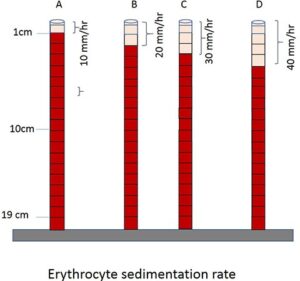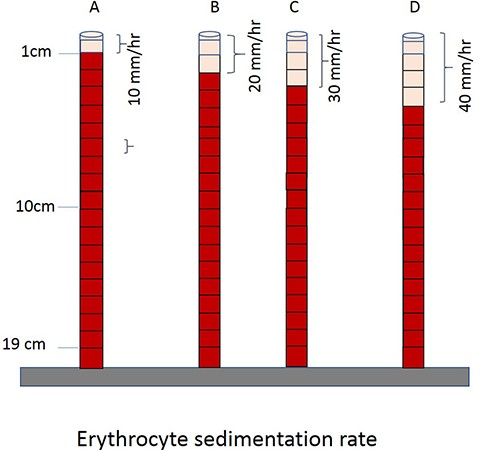
LANDAU Method
Principle
- Erythrocyte Sedimentation Rate (ESR) ek non-specific test hai jo red blood cells (erythrocytes) ke ek vertical column mein ek ghante ke andar kitni doori tak neeche girte hain, ye measure karta hai.
- Iska rate plasma proteins, khas karke fibrinogen aur immunoglobulins, par depend karta hai.
- LANDU method ek common technique hai jisse ESR ka pata lagaya jata hai.
- Is method mein, blood ko ek specially design ki gayi tube mein daala jata hai aur phir usse vertical position mein rakha jata hai.
- Red blood cells ki sedimentation rate ko ek ghante ke baad measure kiya jata hai, jo ki millimeters per hour (mm/hr) mein hoti hai.
Methods
LANDU method, Wintrobe’s tube ki tarah hi hota hai, par yeh ek standardized procedure ka use karta hai accuracy ko enhance karne ke liye. Yeh process kuch is tarah se hota hai:
-
Blood Collection: Blood ko ek anticoagulant jaise sodium citrate mein liya jata hai.
-
Preparation: Blood ko ek specific type ke Landu tube mein daala jata hai, jo uniform diameter aur marked graduations wali hoti hai.
-
Positioning: Tube ko vertical position mein rakha jata hai, generally room temperature par.
-
Time Measurement: Red blood cells ke neeche girne ka time ek ghante mein measure kiya jata hai. Girne ki doori ko millimeters mein measure karke ESR calculate kiya jata hai.
Requirements
-
Blood sample with anticoagulant (jaise sodium citrate ya EDTA).
-
Landu ESR tubes – uniform diameter aur graduation ke sath.
-
Timer – taaki one-hour sedimentation process ko monitor kiya ja sake.
-
Clear aur stable working surface jahan tubes ko vertical position mein rakha ja sake.
-
Incubator (optional) – agar temperature control ki zarurat ho, lekin usually ESR room temperature pe hoti hai.
-
Microscope – kabhi-kabhi plasma layer ki clarity check karne ke liye use hota hai.
Procedure
-
Blood collection: Sterile technique se blood ko anticoagulant tube mein liya jata hai.
-
Mixing: Blood ko gently mix kiya jata hai taaki clotting na ho.
-
Filling the tube: Landu tube ko blood sample se fill kiya jata hai, mark tak.
-
Positioning the tube: Tube ko vertical position mein rakhna zaroori hota hai, disturbance na ho.
-
Measurement: Exactly 1 hour ke baad, jo distance red blood cells neeche gir gaye hain, usse measure kiya jata hai (mm).
-
Recording the result: Measurement ko millimeters mein note kiya jata hai, jo ki ESR ka result hai (mm/hr).
Results 
ESR test ka result woh distance hota hai, jo red blood cells ne 1 hour mein fall kiya hota hai. Agar ESR zyada hai, toh yeh kisi infection ya inflammation ka indication ho sakta hai. Agar ESR low hai, toh iska matlab ho sakta hai ki koi significant inflammatory process nahi hai. Lekin, ESR ek non-specific test hai, jo kai factors se influence ho sakta hai, jaise:
-
Age aur sex: ESR zyada ho sakta hai older adults aur women mein.
-
Pregnancy: Pregnancy ke dauran ESR zyada ho sakti hai.
-
Anemia: Anemia mein ESR zyada ho sakti hai.
Normal ESR values:
-
Men: 0-15 mm/hr
-
Women: 0-20 mm/hr
-
Children: 0-10 mm/hr
Agar ESR normal range se bahar hai, toh yeh kai conditions ko indicate kar sakta hai.
Clinical Significance
ESR test ka use kai cheezon ko detect aur monitor karne ke liye hota hai:
-
Inflammation: ESR rheumatoid arthritis, systemic lupus erythematosus (SLE), aur vasculitis jaise conditions mein zyada hota hai.
-
Infection: Yeh test infections jaise tuberculosis ya bacterial endocarditis ko help kar sakta hai identify karne mein.
-
Cancer: Kuch cancers, jaise lymphomas aur multiple myeloma, mein ESR zyada hota hai.
-
Anemia: Kuch cases mein anemia, especially chronic diseases ke sath, ESR ko badha sakti hai.
-
Chronic kidney disease: ESR kidney diseases mein bhi badh sakta hai, kyunki yahaan systemic inflammation ho sakta hai.
-
Post-surgery or trauma: Surgery ke baad bhi ESR elevated ho sakta hai, jo tissue healing ya complications ko indicate karta hai.